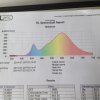Good for you for being active with your keyboard over there. Just an FYI... @goud already showed the 90CRI 3K calced to ~3400K months ago, then
@Malocan confirmed it. An thanks you
@Malocan for doing all that and buying the meter...stepping up like a boss.
Again...real world testing confirming crees real world testing. Just like if you put any other manufacture up against their own data sheet...it's going to be really consistent and well within the stated error ranges. It has nothing to do with cree, citi, bridgelux, nichia..anyone specific. It has to do with actually reading and understanding what is presented by the manufacturer.
So sensei...how does it differ from the posted 3K 90CRI in the data sheets? Cree can call it whatever they want, but things are what they are. And what they are offering as 3K high cri is consistent. You can be pissed and say cree is shitty because their 3K 90cri is 3400K...but doesn't change what it is. Reality is what matters, and this is the reality. You don't need to believe for things to be truths.
And ps...you specifially asked for 3500K 80cri...








